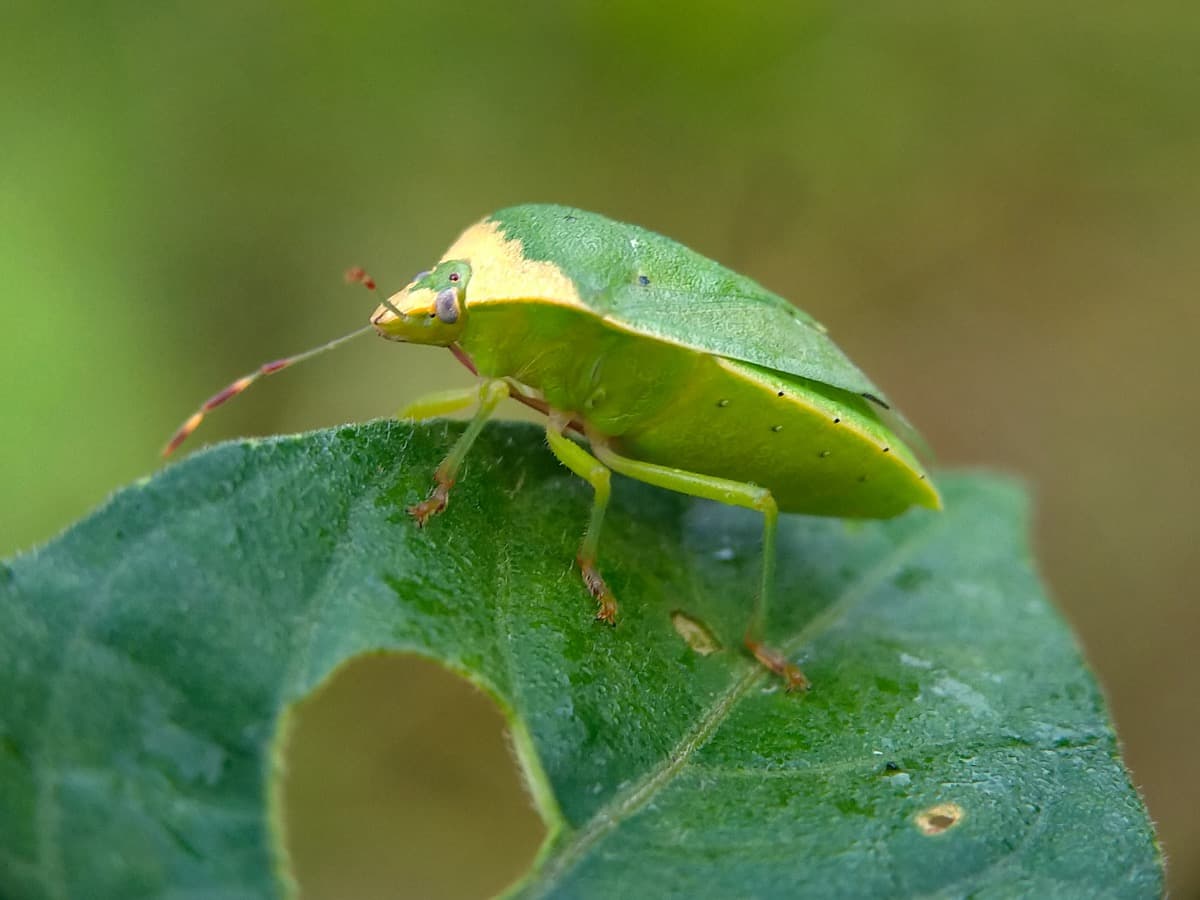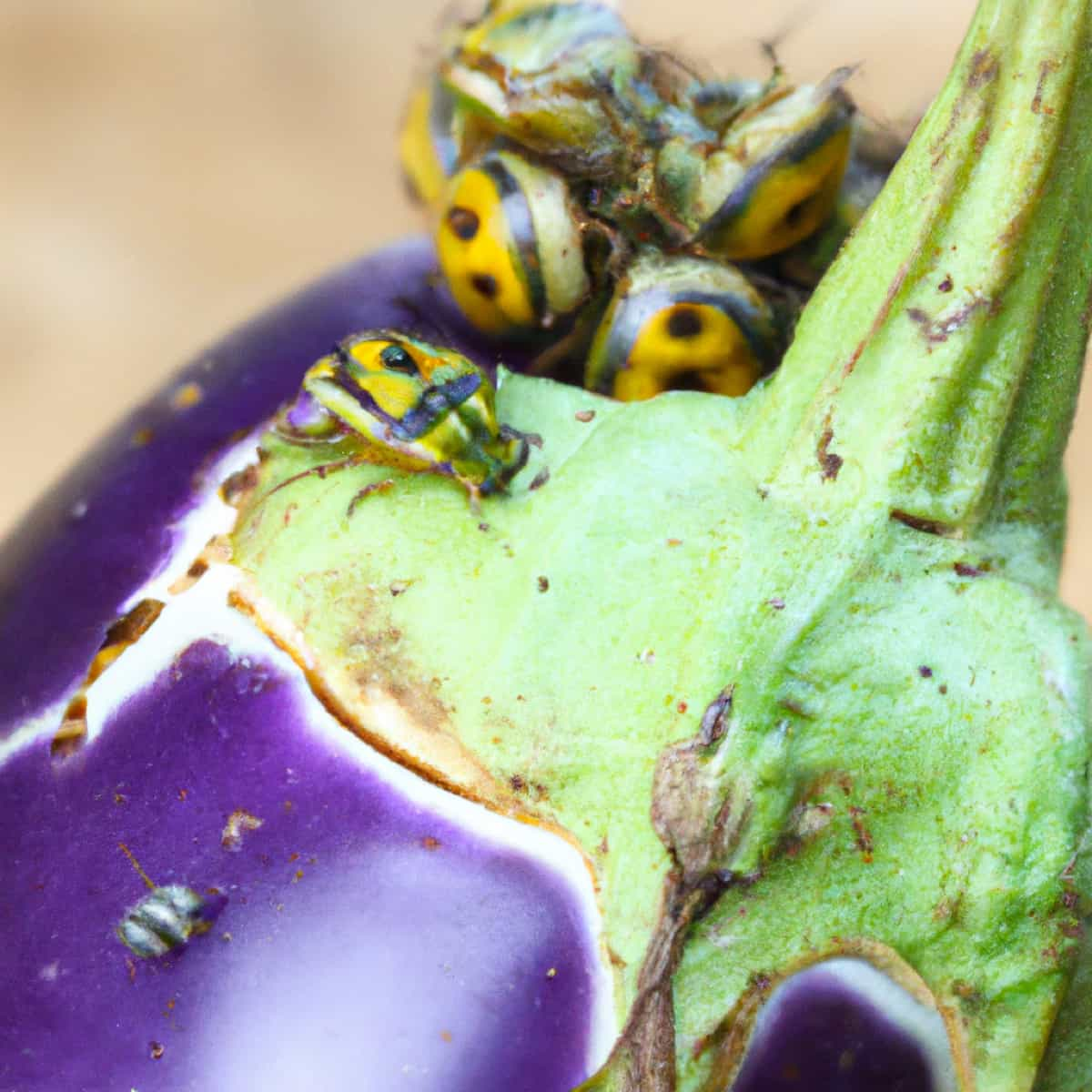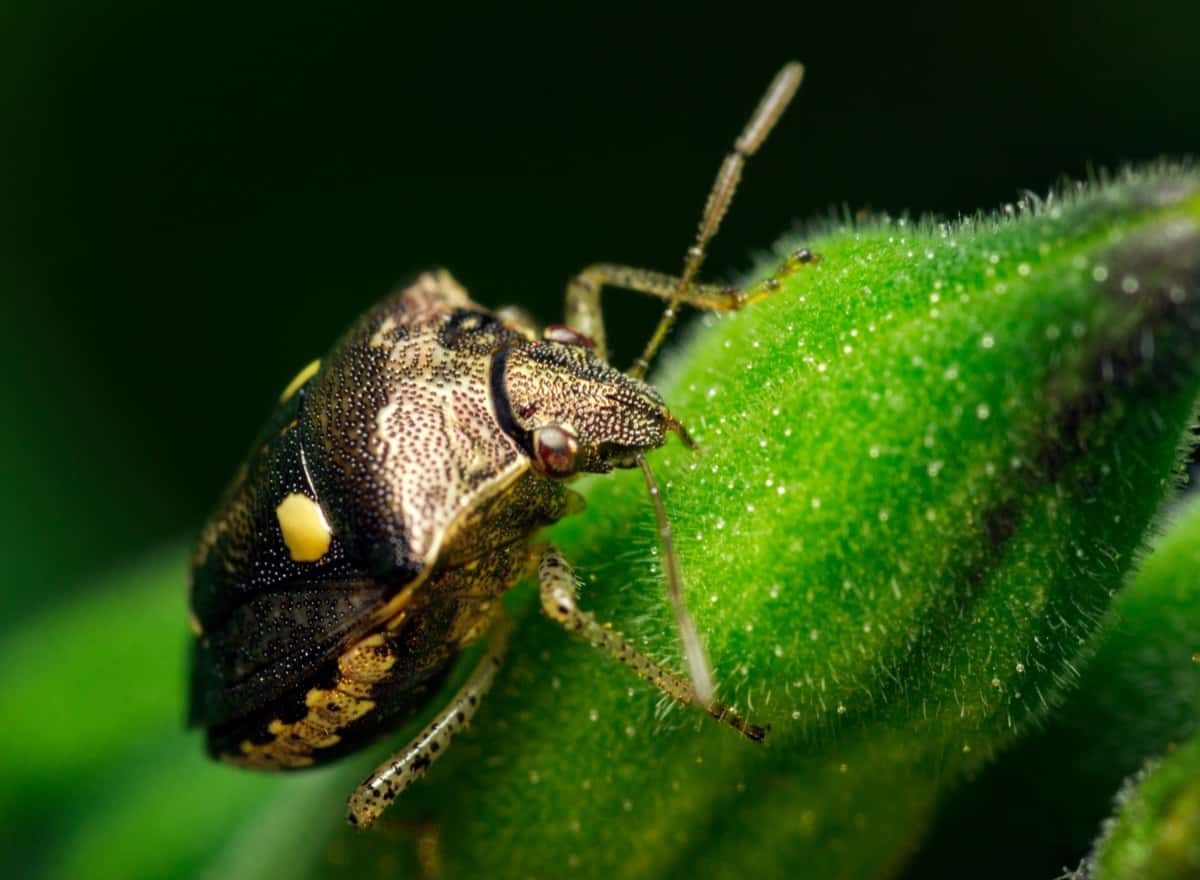Eggplant, or Brinjal, is a popular vegetable prized for its versatility and unique taste. However, various pests often threaten eggplant crops, including the notorious stink bugs. Stink bugs are a type of insect that can cause significant damage to eggplant crops, leading to decreased yields and economic losses for farmers. These bugs damage the fruits and cause other issues, such as unsightly blemishes and reduced quality.

Management of Stink Bugs in Eggplant
The Life Cycle of Stink Bugs
- Eggs are laid by female stink bugs in clusters, usually on the undersides of leaves. The number of eggs in each cluster can vary depending on the stink bug species, with some species laying up to 60 eggs per cluster.
- Once the eggs hatch, the nymph stage begins. The nymphs look very similar to the adult stink bugs but are much smaller. To grow, the nymphs must undergo a process called molting. During molting, the nymphs shed their outer covering or exoskeleton to make room for their larger body. Stink bug nymphs typically go through five molting periods, each known as an “instar.” It’s during the last instar that stink bugs develop their wings.
- After the final molting period, the stink bug enters its adult stage. Adult stink bugs can range in color from brown to green and have a distinct shield-like shape. They can reproduce, and females will continue to lay eggs throughout their lifetime.
- The entire life cycle of a stink bug can take anywhere from 4-6 weeks, depending on the species and environmental conditions.
Identification of Stink Bugs in Eggplant Field
- Egg clusters are common on the underside of leaves, with light-colored clusters of about 25 eggs, up to 60 for brown stink bugs, arranged on end. Brown marmorated eggs are elliptical, while other stink bug eggs are more barrel-shaped.
- Nymphs go through five developmental stages and are flattened like adults but rounder. Brown marmorated stink bug nymphs have short strips of red-brown and black with black and white banding on the antenna and around the abdomen, like adults, plus on legs. Brown stink bug nymphs are yellow-brown to brown, while green stink bug nymphs vary from yellow-orange to black, reddish, and greenish.
- Adult stink bugs are shield-shaped and about 5/8″ in size. Brown marmorated stink bugs are mottled brown and cream with black and white banding on the abdomen edge and the antenna. Brown stink bugs are brown, while green stink bugs are green with white specks.
Damage Symptoms of Stink Bugs in Eggplant Field
- Wilting and stunted growth: Large infestations of stink bugs can cause eggplant plants to wilt, become stunted, and misshapen.
- Misshapen or aborted fruits, seeds, and buds: Stink bugs can cause eggplant plants’ fruits, seeds, and buds to become deformed or even completely aborted.
- Yellow or white blotches on leaves: Stink bugs can cause yellow or white blotches to appear on the leaves of eggplant plants.
- Calluses, blemishes, or depressions: Stink bugs can cause calluses, blemishes, or depressions to appear on the fruits of eggplant plants.
- Black pits on nuts: Stink bugs can cause black pits to appear on the nuts of eggplant plants.
In case you missed it: Management of Silverleaf Whitefly in Eggplant: Symptoms, Treatment, Chemical, Biological, Natural, and Organic Control

Management of Stink Bugs in Eggplant by Cultural Method
- Row covers: Cover your eggplants with row covers to prevent stink bugs from laying eggs on the plant. This can be effective in reducing the population of stink bugs.
- Regular monitoring: Check your eggplants regularly for stink bug activity, especially during the peak season (late summer/early fall). Look for stink bug eggs, nymphs, and adults on the plant and surrounding areas.
- Physical removal: Handpick any visible stink bugs, eggs, and nymphs from the plant and surrounding areas. Drop them in soapy water or a bucket with a few drops of dish soap.
Management of Stink bugs in Eggplant by Biological Method
- Mermithid nematodes are known to infest stink bug adults and nymphs.
- Lacewing larvae, spined soldier bugs, and birds are common predators of stink bugs.
- Stink bug parasitoids include tachinid flies that oviposit on the host’s abdomen. Trichopoda pennipes are a common example.
- Other egg parasitoids include wasps of the genera Trissolcus, Anastatus, and Telenomus. Trissolcus basalis has shown potential against southern green stink bugs in soybean.
Management of Stink bugs in Eggplant by Chemical Method
- Dicrotophos, an organophosphate, is highly toxic to various stink bug species and consistently controls the green stink bug.
- Pyrethroids are effective against green stink bug nymphs and adults.
- Neonicotinoids such as thiamethoxam, dinotefuran, and imidacloprid are efficacious against green stink bug adults, while dinotefuran and clothianidin are efficacious against green stink bug nymphs.
Management of Stink bugs in Eggplant by Organic/Natural Method
Insecticidal soap: Use insecticidal soap or botanicals such as neem or pyrethrum to control stink bug nymphs. These products are only effective on young nymphs, so applying them as soon as you see the first signs of stink bug activity is important. Follow the instructions on the label carefully when using these products.
Preventive Measures for Control of Stink bugs in Eggplant Fields
- Clean up plant debris after the season, especially crucifers and legumes, to eliminate overwintering sites.
- Use row covers, beginning in spring, to physically exclude stink bugs.
- Search for egg masses and crush them, and handpick bugs as an effective control method.
- Knock stink bugs into a container with soapy water held underneath, as they may hide or drop when startled.
- Consider removing thick organic mulch or using plastic, fabric, or rolled paper mulch, as stink bugs may find it a desirable habitat.
- Use insecticides with a short residual to conserve beneficial predators and parasitoids.
- Thick-skinned eggplant cultivars may provide some resistance to stink bug damage.
In case you missed it: Hornworms Management in Eggplant: Symptoms, Treatment, Cultural, Chemical, and Biological Control

Conclusion
Stink bugs are difficult to control, but several preventive measures can be taken to minimize their impact, including cleaning up plant debris, using row covers, handpicking bugs, using soapy water to knock them off plants, cutting out cloudy spots in fruit, removing thick organic mulch, conserving beneficial predators, and using insecticides with a short residual. Additionally, using thick-skinned cultivars may provide some resistance to stink bugs.
- Beneficial Insects in Pest Management
- Natural Solutions for Pest Control in Flower Gardens
- Types of Fungicides Used in Agriculture
- Common Issues in the Fruit Development Stage of Pomegranate Farming
- Fruit Development Issues in Papaya: Easy Solutions and Treatment
- Soil-Borne Diseases and How to Protect Your Plants
- Practices to Prevent Disease Spread in the Garden
- From Wilted to Thriving: How to Treat Root Rot Naturally in Houseplants
- Natural Remedies to Cure Brown Spots on Fig Tree Leaves